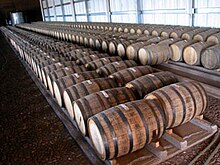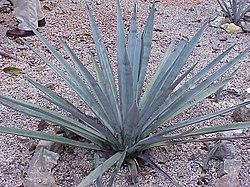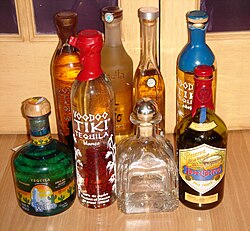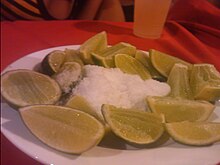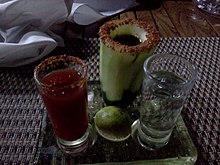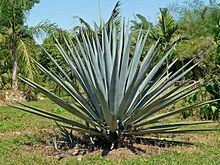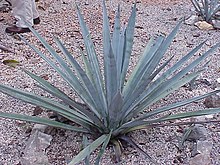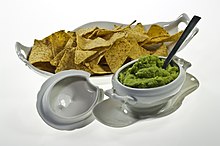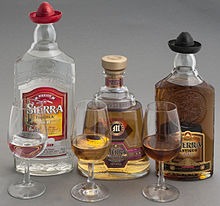
Three varieties of tequila
| |
| Type | distilled beverage |
|---|---|
| Country of origin | Mexico |
| Region of origin | Jalisco |
| Introduced | 16th century |
| Alcohol by volume | 38–55% |
| Proof (US) | 76°–110° |
| Colour | clear, brown or golden |
| Flavour | sweet, fruity, earthy |
| Ingredients | blue agave |
| Variants | Excellia |
| Related products | Mezcal, bacanora, raicilla, pulque |
Blue agave fields near Tequila
Tequila (/tɛˈkiːlə/; Spanish: [teˈkila] ( listen)) is a distilled beverage made from the blue agave plant, primarily in the area surrounding the city of Tequila 65 km (40 mi) northwest of Guadalajara, and in the Jaliscan Highlands (Los Altos de Jalisco) of the central western Mexican state of Jalisco.
listen)) is a distilled beverage made from the blue agave plant, primarily in the area surrounding the city of Tequila 65 km (40 mi) northwest of Guadalajara, and in the Jaliscan Highlands (Los Altos de Jalisco) of the central western Mexican state of Jalisco.
The red volcanic soils in the region of Tequila are well suited
for growing the blue agave, and more than 300 million of the plants are
harvested there each year.
Agave grows differently depending on the region. Blue agaves grown in
the highlands Los Altos region are larger and sweeter in aroma and
taste. Agaves harvested in the lowlands have a more herbaceous fragrance
and flavor. Due to its historical and cultural importance, the region near Tequila was declared a UNESCO World Heritage Site in 2006, the Agave Landscape and Ancient Industrial Facilities of Tequila.
Aside from its geographical distinction, tequila is differentiated from mezcal in that it is made only from blue agave and the beverages are prepared in different ways. Tequila is commonly served neat
in Mexico and as a shot with salt and lime around the world. Tequila
must have between 35- and 55-percent alcohol content (70 and 110 U.S.
proof). It must contain at least 40-percent alcohol (80 U.S. proof) to be sold in the United States and Canada.
History
Early history
A distillery oven loaded with agave piñas or "pineapples", the first step in the production of tequila post harvest.
Tequila was first produced in the 16th century near the location of
the city of Tequila, which was not officially established until 1666. A fermented beverage from the agave plant known as pulque was consumed in pre-Columbian central Mexico before European contact. When the Spanish conquistadors ran out of their own brandy, they began to distill agave to produce one of North America's first indigenous distilled spirits.
Some 80 years later, in around 1600, Don Pedro Sánchez de Tagle, the Marquis of Altamira, began mass-producing tequila at the first factory in the territory of modern-day Jalisco. By 1608, the colonial governor of Nueva Galicia had begun to tax his products. Spain's King Carlos IV granted the Cuervo family the first license to commercially make tequila.
Don Cenobio Sauza, founder of Sauza Tequila and Municipal President of the Village of Tequila from 1884–1885, was the first to export tequila to the United States, and shortened the name from "Tequila Extract" to just "Tequila" for the American markets. Don Cenobio's grandson Don Francisco Javier
gained international attention for insisting that "there cannot be
tequila where there are no agaves!" His efforts led to the practice that
real tequila can come only from the State of Jalisco.
In a move to take ownership of the term “tequila,” the Mexican government declared the term as its intellectual property in 1974. Opening a new door of business opportunity and international gain for the country of Mexico as a whole.
Recent history
A tahona, large stone wheel, at the Hacienda Doña Engracia that was used to crush the piña. Large, modern distilleries commonly complete this process mechanically.
Although some tequilas have remained as family-owned brands, most
well-known tequila brands are owned by large multinational corporations.
However, over 100 distilleries make over 900 brands of tequila in
Mexico and over 2,000 brand names have been registered (2009
statistics). Due to this, each bottle of tequila contains a serial
number (NOM) depicting in which distillery the tequila was produced.
Because only so many distilleries are used, multiple brands of tequila
come from the same location.
In 2003, Mexico issued a proposal that would require all Mexican-made
tequila be bottled in Mexico before being exported to other countries. The Mexican government said that bottling tequila in Mexico would guarantee its quality. Liquor companies in the United States said Mexico just wanted to create bottling jobs in their own country, and also claimed this rule would violate international trade agreements and was in discord with usual exporting practices worldwide.
The proposal might have resulted in the loss of jobs at plants in
California, Arkansas, Missouri, and Kentucky, because Mexican tequila
exported in bulk to the United States is bottled in those plants.
On January 17, 2006, the United States and Mexico signed an agreement
allowing the continued bulk import of tequila into the United States.
The agreement also created a "tequila bottlers registry" to identify
approved bottlers of tequila and created an agency to monitor the
registry.
The Tequila Regulatory Council of Mexico (TRCM) originally did not permit flavored tequila to carry the tequila name.
In 2004, the Council decided to allow flavored tequila to be called
tequila, with the exception of 100% agave tequila, which still cannot be
flavored.
A new Norma Oficial Mexicana (NOM) for tequila (NOM-006-SCFI-2005) was issued in 2006, and among other changes, introduced a class of tequila called extra añejo or "ultra-aged" which must be aged a minimum of three years.
A one-liter bottle of limited-edition premium tequila was sold for $225,000 in July 2006 in Tequila, Jalisco, by the company Tequila Ley .925.
The bottle which contained the tequila was a two-kilo display of
platinum and gold. The manufacturer received a certificate from The Guinness World Records for the most expensive bottle of tequila spirit ever sold.
In June 2013, the ban on importation of premium (100% blue agave)
tequila into China was lifted following a state visit to Mexico by
President Xi Jinping.
The entry of premium tequila into the country is expected to increase
tequila exports by 20 percent within a decade (exports totaled 170
million liters in 2013). Ramon Gonzalez, director of the Consejo Regulador del Tequila, estimates that each of the top 16 producers of tequila had invested up to $3 million to enter the Chinese market. On 30 August 2013, the first 70,380 bottles of premium tequila from ten brands arrived in Shanghai. The arrival happened during an event held at the House of Roosevelt, a well-known club located on The Bund– an area with a long tradition of importing alcoholic beverages in China.
The latest version of the tequila standard (NOM-006-SCFI-2012)
also updated the standard to specify that the silver class of tequila
cannot contain additives, to allow the aging time for the ultra aged
class to be displayed on the label, to prohibit the commercialization of
bulk tequila through vending machines, and required registering the
agave during the calendar year of its plantation and required annual
updates.
In 2018, the Mexican government approved a proposal to celebrate the third Saturday of March as National Tequila Day.
Production
A jimador or a worker who harvests the agaves and cuts off the sharp leaves
Planting, tending, and harvesting the agave plant remains a manual
effort, largely unchanged by modern farm machinery and relying on
centuries-old know-how. The men who harvest it, the jimadores [ximaˈðoɾes], have intimate knowledge of how the plants should be cultivated, passed down from generation to generation.
By regularly trimming any quiotes [ˈkjotes] (a several-meter high stalk that grows from the center of the plant), the jimadores prevent the agave from flowering and dying early, allowing it to fully ripen. The jimadores must be able to tell when each plant is ready to be harvested, and using a special knife called a coa (with a circular blade on a long pole), carefully cut away the leaves from the piña (the succulent core of the plant). If harvested too late or too early, the piñas, which can average around 70 kg (150 lb) in the lowlands to 110 kg (240 lb) in the highlands, will not have the right amount of carbohydrates for fermentation.
After harvesting, the piñas [ˈpiɲas] are transported to ovens where they are slowly baked to break down their complex fructans into simple fructoses. Then, the baked piñas are either shredded or mashed under a large stone wheel called a tahona [taˈona]. The pulp fiber, or bagazo [baˈɣaθo],
left behind is often reused as compost or animal feed, but can even be
burnt as fuel or processed into paper. Some producers like to add a
small amount of bagazo back into their fermentation tanks for a stronger agave flavor in the final product.
The extracted agave juice is then poured into either large wooden
or stainless steel vats for several days to ferment, resulting in a wort, or mosto [ˈmosto], with low alcohol content. This wort is then distilled once to produce what is called ordinario [oɾðiˈnaɾjo], and then a second time to produce clear "silver" tequila. Using at least two distillations is required by law. A few producers such as Casa Noble (for their "Crystal" expression) and Corzo (for their añejo
expression) have experimented with distilling the product a third time,
but this has not caught on as a trend, and some have said it removes
too much of the agave flavor from the tequila.
From there, the tequila is either bottled as silver tequila, or it is
pumped into wooden barrels to age, where it develops a mellower flavor
and amber color.
The differences in taste between tequila made from lowland and
highland agave plants can be noticeable. Plants grown in the highlands
often yield sweeter and fruitier-tasting tequila, while lowland agaves
give the tequila an earthier flavor.
Fermentation
Unlike other tequila production steps, fermentation
is one of the few steps out of the control of human beings.
Fermentation is the conversion of sugars and carbohydrates to alcohol
through yeast in anaerobic conditions, meaning that oxygen is not present during the process. Fermentation is also carried out in a non-aseptic environment which increases the bacterial activity of tequila. The participation of microorganisms
from the environment (yeasts and bacteria) makes fermentation a
spontaneous process which gives rise to many byproducts that contribute
to the flavor and aroma of tequila.
During the fermentation process, inoculum
is added to the batch to speed the rate of fermentation. When inoculum
is added, fermentation can take approximately 20 hours to 3 days. If
inoculum is not added, fermentation could take up to 7 days. The rate of
fermentation is a key factor in the quality and flavor of tequila
produced. Worts fermented slowly are best because the amount of
organoleptic compounds produced is greater. The alcohol content at the
end of fermentation lies between 4-9%.
Organoleptic compounds
Tequila Fermentation Vessel in City of Tequila Museum
Organoleptic compounds enhance flavor and aroma. These include fusel oil, methanol, aldehydes, organic acids and esters. Production of isoamyl and isobutyl
alcohols begins after the sugar level is lowered substantially and
continues for several hours after the alcoholic fermentation ends. In
contrast, ethanol production begins in the first hours of the
fermentation and ends with logarithmic yeast growth. The alcohol content
in tequila is affected by three factors: the amount of isoamyl alcohol
and isobutanol in the yeast strain, the carbon:nitrogen ratio (the higher the ratio, the more alcohol produced), and the temperature of fermentation.
The higher the temperature, the greater concentration of isobutyl
and isoamyl alcohols produced. Although if temperatures are too high,
this can cause the yeast to become less effective. Similarly, if the
temperature is too low, the process occurs too slowly.
This can become a large issue in Central Mexico, most precisely the
city of Tequila, Jalisco, where most tequila is processed. The average
annual temperatures in the city of Tequila can reach 31C. For this reason, tequila producers often use large stainless steel tanks for fermentation.
Yeast
Organoleptic
compounds are dependent on yeast. The role of yeast is, through many
enzymatic processes, to turn sugars and carbohydrates into alcohol.
There are two steps, first in aerobic conditions, yeast is doubled in
colony size every four hours. This process goes on for 24–48 hours.
Next, yeast turns acetaldehyde into ethyl alcohol which is known as one
of the organoleptic compounds produced in fermentation.
The two main categories of yeast used in tequila are commercial
brewers yeast and yeast that comes from precultivated existing yeast
that has been preserved. The use of either type of yeast can result in
different end products of tequila.
Chemistry
Alcohol content
Saccharomyces cerevisiae, under a microscope
Tequila is a distilled beverage that is made from the fermentation of
the sugars found from the blue agave plant once it has been cooked, the
main sugar being fructose. Through the fermentation process, many factors influence the higher alcohol content of tequila, which are molecules such as isobutyl alcohol and isoamyl alcohol, and ethanol.
These parameters include the type of yeast strain, the age of the agave
plant itself, temperature, and the carbon:nitrogen ratio.
However, the type of yeast strain used and the carbon:nitrogen
factors have the biggest influence on the production of higher alcohols;
this is not surprisingly as higher alcohol and ethanol production is an
intrinsic property of the metabolism of each strain. The type of yeast most commonly found in tequila is Saccharomyces cerevisiae, which contains many strains.
For example, CF1 agaves, a type of yeast, produces much more ethanol
than a strain of CF2, as the two yeasts' metabolism mechanisms differ.
This factor may be influenced from different agricultural practices
that occur to cultivate the different yeasts strains. It was found that
the higher the carbon:nitrogen ratio, the higher the production of
higher alcohols such as isobutyl alcohol and isoamyl alcohol. A high
ratio imparts that there is less nitrogen in the fermentation process,
which results in deamination reactions of amino acids, leading to the synthesis of higher alcohols. The Ehrlich pathway is the name for this process, where alpha-keto acids are decarboxylated and transformed to aldehydes and to higher alcohols.
The temperature of the fermentation process also greatly effects
the alcohol content of the resulting product. For example, a study
conducted by Pinal et al. found that cultivating two strains at a
temperature of 35 degrees as compared to a temperature of 30 degrees
produced more isoamyl alcohol. The higher temperature suggests that this
is a much more optimal condition for the yeast to ferment the distilled
beverage.
Lastly the age of the agave plant itself: the older the plant,
the greater the alcohol production. It was shown in a study that the
concentration of amyl alcohol increased as the plant aged by a factor
30%. However, a higher concentration of methanol is found when using
younger plants. This may be due to differences in agricultural practices
that occur when taking care of plants of different ages.
Color
Tequila
comes in an abundant array of colors that ranges from a simple clear
distilled beverage to a dark amber brown. The color of the tequila
varies greatly depending on the aging process and the type of wood used
for storage.
The white version of tequila, known as silver tequila or blanco, is the
product obtained without a (or with very short) aging process. As well,
the spirit must contain 38–55% alcohol content, which is fermented from
a wort that contains no less than 51% sugars from the agave plant.
Silver tequila provides the purest form as little aging has occurred.
What is known as gold, joven or oro tequila is usually silver tequila
with the addition of grain alcohols and caramel color;
however, some higher-end gold tequilas may be a blend of silver and
reposado. Rested (reposado) or aged tequila (añejo) is aged in wooden
containers.
The aging process can last between two months and three years and can
create or enhance flavors and aromas. The aging process generally
imparts a golden color.
Flavor and aroma
There
are more than 300 known compounds in tequila, many of which are
produced during the fermentation process, the raw material used, and to a
lesser degree during the maturation.
The components that make up tequila do not act individually to give
tequila its distinctive flavor and aroma, but rather, depend on the
interaction and quantity of each volatile compound. The volatile compounds responsible for the flavor and aroma profiles of the tequila are put into a category called organoleptic compounds and are known to increase in concentration with a slower fermentation process. The organoleptic compounds produced during fermentation include higher order alcohols, methanol, esters, carbonyls, terpenes, and furans.
Higher-order alcohols have a strong aroma, and the quantity
present in each tequila depends on the carbon:nitrogen ratio and
temperature during the cooking and fermentation processes. Some of the most common alcohols present other than ethanol are: isoamyl alcohol, isobutanol, and 1-propanol.[citation needed] Methanol is thought to be mainly generated through hydrolysis of methylated pectin
which is naturally present in the agave plant, but there has been
speculation that it is also partly produced from the enzymatic reactions
of yeast strains containing pectin methyl esterase enzyme, which break
up the methoxyl group from the pectin. Nearly 50 different esters are identified in tequila, which together give rise to the fruit-like flavors and smell. One of the most abundant esters is ethyl acetate which is synthesized during fermentation by the yeast Saccharomyces cerevisiae, using alcohol transferase enzyme which links acetic acid to ethanol.
In general, the longer the controlled fermentation period, the higher yield of esters produced. During the fermentation process, ethanol is oxidized and one of the main compounds produced are acetaldehydes, which adds the flavor necessary for the final product of tequila.
For example, isovalderaldehyde seems to produce a sweet, cocoa, and
chocolate-like flavor. 2 and 3-methylbutanal produce a malty flavor. The agave plant contains many phenolics such as vanillin and syringaldehydes which presents a strong and fruity or herbal aroma. It also contains eugenol which can deliver a hint of spicy flavor to the tequila. Since the production of tequila involves heating, Maillard browning reactions occur, and furans are produced during the thermal degradation of sugar. The most prominent furanic compounds include 2-furaldehyde and 5-methylfuraldehyde, which can contribute to the smoky flavor of tequila.
Guaiacol also seems to contribute to Tequila's smoky flavor.
Beta-demascenone contributes to the woody, floral taste of tequila.
Volatile compounds that contribute to the overall taste and aroma of tequila can be quantitatively assessed and evaluated by gas chromatography. Discrimination tests such as duo-trio and triangle tests are also used to evaluate the quality of the tequila.
Aging
Process
Barrel room for aged (añejo) tequila
If silver or white tequila is the desired final product, distillation is the final process it undergoes. Rested (Reposado) or aged (Añejo)
tequila must be matured in 200-liter (or larger) white oak barrels for
at least two months for the former and 12 months for the latter. There
are, however, more than 50 different companies producing tequila in the
Mexican province of Jalisco, with different maturation times according to the variety of tequila and desired quality of the final product.
All companies producing tequila have their aging processes regulated and fiscalized by the Mexican government.
Chemistry
The
maturation process causes four main chemical transformations to the
tequila compounds: (1) decreasing of fusel oils by the char in barrels,
which acts as an absorbing agent; (2) extraction of complex wood
constituents by tequila, giving specific aroma and flavor to the final
product; (3) reactions among the components of tequila, creating new
chemical compounds; and (4) oxidation of the original contents of
tequila and of those extracted from wood. The final results of these
changes are increased concentrations of acids, esters and aldehydes, and
a decrease in fusel oil concentration.
Tequila being rested or aged in oak barrels
Reposado may be rested in oak
barrels or casks as large as 20,000 liters (5,280 gallons), allowing
for richer and more complex flavors. The preferred oak comes from the
US, France, or Canada, and is usually white oak. Some companies char the
wood to impart a smoky flavor or use barrels previously used with
different kinds of alcohol (e.g. whiskey or wine). Some reposados can also be aged in new wood barrels to achieve the same woody flavor and smoothness, but in less time.
Añejos are often rested in barrels previously used to rest reposados.
The barrels cannot be more than 600 liters (158 gallons), and most are
in the 200-liter (52-gallon) range. Many of the barrels used are from
whiskey distilleries in the US or Canada, and Jack Daniels barrels are
especially popular. This treatment creates many of the aspects of the dark color and more complex flavors of the añejo tequila. After aging of at least one year, the añejo can be removed from the wood barrels and placed in stainless steel tanks to reduce the amount of evaporation that can occur in the barrels.
Threats to quality
TMA (tristeza y muerte de agave — "agave depression and death") is a blight
that has reduced the production of the agave grown to produce tequila.
This has resulted in lower production and higher prices throughout the
early 21st century, and due to the long maturation of the plant, will
likely continue to affect prices for years to come.
"Tequila worm" misconception
Only certain mezcals, usually from the state of Oaxaca, are ever sold con gusano (with worm). They are added as a marketing gimmick and are not traditional. The tequila regulatory council does not allow gusanos or scorpions (which are sometimes also added to mezcals) to be included in tequila bottles. The worm is actually the larval form of the moth Hypopta agavis, which lives on the agave
plant. Finding one in the plant during processing indicates an
infestation and, correspondingly, a lower-quality product. However, this
misconception continues, despite effort and marketing to represent
tequila as a premium liquor.
Norma Oficial Mexicana
A young agave plant
The Norma Oficial Mexicana
(NOM) applies to all processes and activities related to the supply of
agave, production, bottling, marketing, information, and business
practices linked to the distilled alcoholic beverage known as tequila. Tequila must be produced using agave of the species Tequilana Weber Blue variety, grown in the federal states and municipalities indicated in the Declaration.
Furthermore, the NOM establishes the technical specifications and
legal requirements for the protection of the Appellation of Origin of
"Tequila" in accordance with the current General Declaration of
Protection of the Appellation of Origin of "Tequila", the Law, the Industrial Property Law, the Federal Consumer Protection Law and other related legal provisions.
All authentic, regulated tequilas will have a NOM identifier on
the bottle. The important laws since 1990 were NOM-006-SCFI-1993, the
later updates NOM-006-SCFI-1994 and NOM-006-SCFI-2005 and the most
recent revision published on December 13, 2012, NOM-006-SCFI-2012.
The number after NOM is the distillery number, assigned by the
government. NOM does not indicate the location of the distillery, merely
the parent company or, in the case where a company leases space in a
plant, the physical plant where the tequila was manufactured.
Storage condition
Unlike wine that contains tannins
which may change over time, even in a bottle if proper storage
conditions are not met, spirituous liquors like tequila do not change
much once they are bottled.
Since tequila is a distilled liquor, it does not require strict storage
conditions like wine does, and the same goes with most other distilled
spirits such as whiskey, rum, or vodka.
Furthermore, because the characteristics and certain quality (flavor,
aroma, color, etc.) of the tequila are determined during the aging
process inside wood barrels, the quality of the tequila should remain
relatively constant after they are bottled.
To maintain the quality of tequila, at least three conditions should be
met: constant and moderate temperature (60 to 65 °F), no exposure to
direct sunlight, and maintenance of proper seal of the bottle. Also,
storage conditions will have more effect on the taste of aged tequila
rather than the un-aged tequila, due to tannins and other compounds
introduced into the spirit from the aging barrel.
For instance, if stored in improper conditions, the dark and more
complex flavors of the añejo tequila are more likely to be tainted than
the blanco or the silver tequila.
Once the bottle is opened, the tequila will be subject to oxidation
which will continue to happen even if no more oxygen is introduced. In
addition, if the bottle has more room for air, the process of oxidation
occurs faster on the liquor remaining inside the bottle. Therefore, it may be the best to consume the tequila within one or two years after opening. For the most part, the change in quality of tequila is due to extreme conditions of improper storage, not due to oxidation.
Types
Tequilas of various styles
The two basic categories of tequila are mixtos and 100% agave. Mixtos use no less than 51% agave, with other sugars making up the remainder. Mixtos use both glucose and fructose sugars.
There are also four categories for tequila, depending on the aging period:
- Blanco [ˈblaŋko] ("white") or plata [ˈplata] ("silver"): white spirit, unaged and bottled or stored immediately after distillation, or aged less than two months in stainless steel or neutral oak barrels
- Reposado [repoˈsaðo] ("rested"): aged a minimum of two months, but less than a year in oak barrels of any size
- Añejo [aˈɲexo] ("aged" or "vintage"): aged a minimum of one year, but less than three years in small oak barrels
- Extra Añejo ("extra aged" or "ultra aged"): aged a minimum of three years in oak barrels; this category was established in March 2006.
With 100% agave tequila, blanco or plata is harsher with the bold flavors of the distilled agave up front, while reposado and añejo
are smoother, subtler, and less complex. As with other spirits aged in
casks, tequila takes on the flavors of the wood, while the harshness of
the alcohol mellows. The major flavor distinction with 100% agave
tequila is the base ingredient, which is more vegetal than grain spirits
(and often more complex).
Brands
The Consejo Regulador del Tequila (Tequila Regulatory Council) reported 1377 registered brands from 150 producers for the year 2013.
Serving
Salt and lime
In Mexico, the most traditional way to drink tequila is neat, without
lime and salt. It is popular in some regions to drink fine tequila with
a side of sangrita—a sweet, sour, and spicy drink typically made from orange juice, grenadine (or tomato juice), and hot chilli. Equal-sized shots of tequila and sangrita are sipped alternately, without salt or lime. Another popular drink in Mexico is the bandera (flag, in Spanish), named after the Flag of Mexico, it consists of three shot glasses, filled with lime juice (for the green), white tequila, and sangrita (for the red).
Outside Mexico, a single shot of tequila is often served with salt and a slice of lime. This is called tequila cruda
and is sometimes referred to as "training wheels", "lick-sip-suck", or
"lick-shoot-suck" (referring to the way in which the combination of
ingredients is imbibed). The drinkers moisten the back of their hands
below the index finger (usually by licking) and pour on the salt. Then
the salt is licked off the hand, the tequila is drunk, and the fruit
slice is quickly bitten. Groups of drinkers often do this
simultaneously. Drinking tequila in this way is often erroneously called
a Tequila Slammer,
which is in fact a mix of tequila and carbonated drink. Though the
traditional Mexican shot is tequila by itself, lime is the fruit of
choice when a chaser must be used.
The salt is believed to lessen the "burn" of the tequila and the sour
fruit balances and enhances the flavor. In Germany and some other
countries, tequila oro (gold) is often consumed with cinnamon on a slice of orange after, while tequila blanco (white) is consumed with salt and lime.
Bandera of Mexican tequila
If the bottle of tequila does not state on the label that it is
manufactured from 100% blue agave (no sugars added), then, by default,
that tequila is a mixto (manufactured from at least 51% blue
agave). Some tequila distilleries label their tequila as "made with blue
agave" or "made from blue agave". However, the Tequila Regulatory
Council has stated only tequilas distilled with 100% agave can be
designated as "100% agave".
Some distillers of lower-quality tequila have marketed their
product to be served "ice-cold chilled" when used as a shot. Chilling
any alcohol can be used to reduce the smell or flavors associated with a
lower-quality product. Any alcoholic product, when served as a chilled
shot, may be more palatable to the consumer.
Many of the higher-quality, 100% agave tequilas do not impart significant alcohol burn, and drinking them with salt and lime is likely to remove much of the flavor. These tequilas are usually sipped from a snifter glass
rather than a shot glass, and savoured instead of quickly gulped. Doing
so allows the taster to detect subtler fragrances and flavors that
would otherwise be missed.
Tequila glasses
A margarita glass
When served neat (without any additional ingredients), tequila is most often served in a narrow shot glass called a caballito (little horse, in Spanish),[52] but can often be found in anything from a snifter to a tumbler.
The Consejo Regulador del Tequila approved an "official tequila glass" in 2002 called the Ouverture Tequila glass, made by Riedel.
The margarita glass, frequently rimmed with salt or sugar, is a staple for the entire genre of tequila-based mixed drinks, including the margarita.
Cocktails
A variety of cocktails are made with tequila, including the margarita, a cocktail that helped make tequila popular in the United States. The traditional margarita uses tequila, Cointreau, and lime juice, though many variations exist. A popular cocktail in Mexico is the Paloma. Also, a number of martini variants involve tequila, and a large number of tequila drinks are made by adding fruit juice. These include the Tequila Sunrise and the Matador. Sodas and other carbonated drinks are a common mixer, as in the Tequila Slammer. Other popular cocktails are the Acapulco cocktail, Bloody Aztec Chimayó Cocktail, Mexican martini, Mojito Blanco and Vampiro.
Regulation outside of Mexico
Canada
Under
Canadian regulations (C.R.C., c.870, section B.02.90), any product
labelled, advertised, or sold as Tequila must be manufactured in Mexico,
as it would be for consumption in Mexico. However, once imported to
Canada for sale, it is legal for Tequila to be diluted with bottled or purified water to adjust it to the desired strength and then sold.
United States
Similar
to the law of Canada, the U.S. law (27 CFR 5.22 (g)) says that tequila
must be "manufactured in Mexico in compliance with the laws of Mexico
regulating the manufacture of Tequila for consumption in that country".
However, Tequila cannot be sold in the U.S. at under 40% alcohol
concentration (80 U.S. proof).







